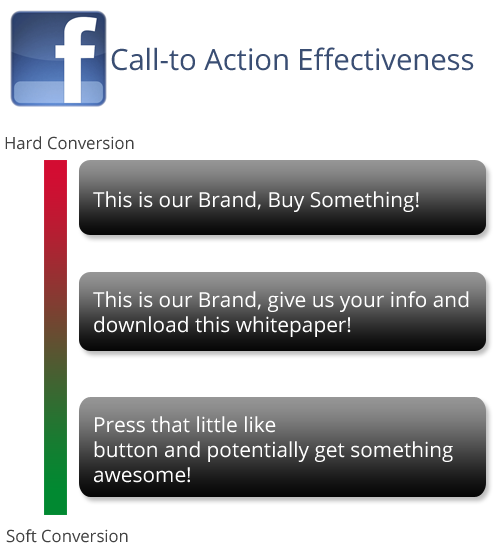Facebook performs much more similarly to, say, a content network than a paid search advertising platform (both generally provide display network like click-through and conversion rates). The reason a Facebook ad will likely underperform when compared to a search-based ad is simple: intent.
Search users are typically expressing a direct intent in a product or service and then an ad is displayed. This creates a scenario in which the search user is later in the buy cycle and thus more likely to execute a purchase (especially when compared to a Facebook user that has entered the site to look at vacation photos of high school acquaintances). This means—at least for most companies—that Facebook is relegated to the less profitable brand advertising space and, as a result, generates only $4/user annually (compared to Google’s $24/user).
All of this might appear to be painting a pretty grim picture for advertisers, but it’s important to understand that Facebook is a different medium with entirely unique advantages that include the:
- Ability to create a long-term relationship with a customer and thus increasing lifetime value/recurring revenue.
- Ability create an audience for PR distribution and viral content efforts.
- Opportunity deeply educate a potential customer and advance them in the buy cycle.
Here are four ways to rethink a paid Facebook campaign.
1. Restructure Your Search Paradigm
Relative to paid social, search is a clean transaction. Typically, an advertiser will have a strong understanding of the earned revenue the very day spend occurs.
Facebook advertising is a very different model than paid search, as the return on investment (ROI) could happen six months after the Like is acquired, if ever. I often recommend the following tactics to “de-search” your paid social campaigns:

- Soften Your Call-to-Actions: If we can safely assume the path to revenue needs to be longer than search, doesn’t it make sense of soften your call-to-action (CTA)? Figure out great ways to incentivize your audience. Maybe it’s offering an opportunity to win a really cool prize or maybe it’s a cause-based donation in exchange for a like. Mitigate risk to build the relationship and focus on long-term education.
- Incentivize Offers: “Like us to get updates about our products and services” just isn’t going to get the job done. Think creatively about what will specifically appeal to your target audience in terms of a sweepstakes, contest, or charitable donation. Ideally, the offering will relate tangentially (at the least) to your product. For example, a travel aggregator might create a “plan the trip of your dream” contest where entrance is contingent upon the Like. It could then be fan voted where the winner receives the trip.
- Make Ads CTA-based: Unlike search ads, which usually are usually structured as feature/benefit/CTA, Facebook ads should revolve almost entirely around the CTA and its specific benefits. Again, assuming it’s a longer path to revenue, use future posts as the mechanism to slowly educate your potential consumer.
2. Don’t Over-Commit Media Spend
For most audiences, it’s helpful to think of Facebook as somewhere between a branding and PR play. Having an engaged audience of 10,000 users is a great way to increase long-term engagement and control the sentiment revolving around a brand, but put social spending in its place: a great tool, but not one for building short-term revenue.
For most companies, I wouldn’t recommend pulling +EV (Plus Expected Value) search budget. Instead, peel off some of that branding/PR budget and apply to paid social campaigns.
3. Track Follow-up Marketing
Acquiring a social following is great, but making the decision to continue the investment is dependent upon your pilot results. Use campaign URL tracking to determine the level of traffic and conversions that follow. Additionally, look for additional PR signals that may create ancillary benefits in other marketing channels (see: incoming links from evangelists).
After you’ve completed your pilot test and have acquired 2,000 likes, try 60 days of content dissemination to measure CTR, time on site, and conversions. This can then be used to project and extrapolate ROI on future campaigns.
4. Make Sure Your Company is a Good Fit
If you sell a $39.99 need-based one-off, Facebook might never be the wisest route.
However, if you are selling a service or product that requires recurring revenue (e.g., any consumer staple) in which the lifetime value of a customer will be measured over years, Facebook becomes a significantly more logical play. For services that require constant messaging in order to stay “top-of-mind,” having a massive following becomes extremely advantageous, especially when considering that all follow up messaging will be free/low cost.
Remember
Having 10,000 Facebook Likes is a fantastic audience through which to disseminate content to help lubricate viral sharing. It’s also a transparent and central place to engage customers, build brand, listen to feedback, and earn trust. Just be weary of any company that presents social as a quick path to revenue.
